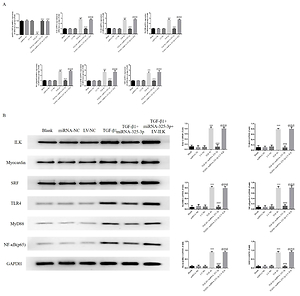Current issue
Archive
Manuscripts accepted
About the Journal
Editorial office
Editorial board
Section Editors
Abstracting and indexing
Subscription
Contact
Ethical standards and procedures
Most read articles
Instructions for authors
Article Processing Charge (APC)
Regulations of paying article processing charge (APC)
UROLOGY / BASIC RESEARCH
miRNA-325-3p overexpression mitigates partial bladder outlet obstruction (PBOO) by regulating the TLR4/NF-kB(p65) pathway
1
Department of Urology, Affiliated Lianyungang Hospital of Nanjing University of Chinese Medicine, Lianyungang, China
2
Department of Urology, The Second Affiliated Hospital of Nanjing Medical University, Nanjing, China
3
Major in Clinical Medicine, Nanjing Medical University, Nanjing, China
4
Department of Urology, Jiangnan University Affiliated Hospital, Wuxi, China
Submission date: 2021-05-26
Final revision date: 2021-07-08
Acceptance date: 2021-07-20
Online publication date: 2021-08-04
Corresponding author
KEYWORDS
TOPICS
ABSTRACT
Introduction:
MicroRNA (miRNA) is a noncoding RNA that plays an important role in many diseases. Partial bladder outlet obstruction (PBOO) is a blockage between the outlet of the neck of the bladder and the external urethral orifice secondary to prostate hyperplasia and urethral stricture, and causative of morphological and functional abnormalities in the bladder. We examine the effects of miRNA-325-3p on PBOO and related mechanisms through an in-vitro study.
Material and methods:
Primary bladder smooth muscle cells (BSMCs) were extracted from SD rats and subjected to TGF-1 stimulation to form a cell model of PBOO. Cell proliferation was measured by CCK-8 assay, and the gene and protein expression levels were measured by RT-qPCR, western blot, and immunofluorescence. The correlation between miRNA-325-3p and ILK was analyzed through a double-luciferase target experiment.
Results:
The proliferation of BSMCs in the model group increased more significantly than in the normal group (p < 0.001) with miRNA-325-3p repression, and led to activation of the ILK and the TLR4/NF-B(p65) pathway as well as significant changes in the marker proteins. With miRNA-325-3p transfection, the rate of cell proliferation of the miRNA-325-3p group was significantly suppressed with ILK repression compared with that of the model group, and led to the suppression of TLR4/NF-B(p65) activity and the regulation of protein expression. However, the miRNA-325-3p treatment’s effects disappeared as ILK was supplemented. The double-luciferase experiment helped miRNA-325-3p target ILK in BSMCs.
Conclusions:
miRNA-325-3p overexpression may play a key role in PBOO-induced cell proliferation by targeting ILK and suppressing the TLR4/NF-B(p65) signaling pathway.
MicroRNA (miRNA) is a noncoding RNA that plays an important role in many diseases. Partial bladder outlet obstruction (PBOO) is a blockage between the outlet of the neck of the bladder and the external urethral orifice secondary to prostate hyperplasia and urethral stricture, and causative of morphological and functional abnormalities in the bladder. We examine the effects of miRNA-325-3p on PBOO and related mechanisms through an in-vitro study.
Material and methods:
Primary bladder smooth muscle cells (BSMCs) were extracted from SD rats and subjected to TGF-1 stimulation to form a cell model of PBOO. Cell proliferation was measured by CCK-8 assay, and the gene and protein expression levels were measured by RT-qPCR, western blot, and immunofluorescence. The correlation between miRNA-325-3p and ILK was analyzed through a double-luciferase target experiment.
Results:
The proliferation of BSMCs in the model group increased more significantly than in the normal group (p < 0.001) with miRNA-325-3p repression, and led to activation of the ILK and the TLR4/NF-B(p65) pathway as well as significant changes in the marker proteins. With miRNA-325-3p transfection, the rate of cell proliferation of the miRNA-325-3p group was significantly suppressed with ILK repression compared with that of the model group, and led to the suppression of TLR4/NF-B(p65) activity and the regulation of protein expression. However, the miRNA-325-3p treatment’s effects disappeared as ILK was supplemented. The double-luciferase experiment helped miRNA-325-3p target ILK in BSMCs.
Conclusions:
miRNA-325-3p overexpression may play a key role in PBOO-induced cell proliferation by targeting ILK and suppressing the TLR4/NF-B(p65) signaling pathway.
Share
RELATED ARTICLE
We process personal data collected when visiting the website. The function of obtaining information about users and their behavior is carried out by voluntarily entered information in forms and saving cookies in end devices. Data, including cookies, are used to provide services, improve the user experience and to analyze the traffic in accordance with the Privacy policy. Data are also collected and processed by Google Analytics tool (more).
You can change cookies settings in your browser. Restricted use of cookies in the browser configuration may affect some functionalities of the website.
You can change cookies settings in your browser. Restricted use of cookies in the browser configuration may affect some functionalities of the website.



